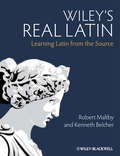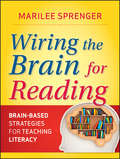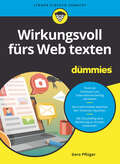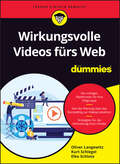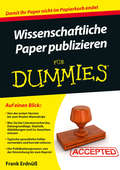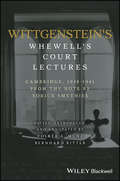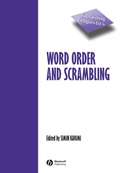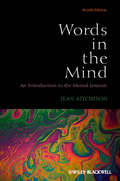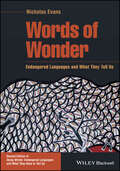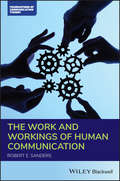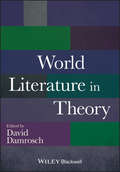- Table View
- List View
The Wiley-Blackwell Encyclopedia of Eighteenth-Century Writers and Writing 1660 - 1789
by Paul Baines Julian Ferraro Pat RogersThe Wiley-Blackwell Encyclopedia of Eighteenth-Century Writers and Writing1660-1789 features coverage of the lives and works of almost 500 notable writers based in the British Isles from the return of the British monarchy in 1660 until the French Revolution of 1789. Broad coverage of writers and texts presents a new picture of 18th-century British authorship Takes advantage of newly expanded eighteenth-century canon to include significantly more women writers and labouring-class writers than have traditionally been studied Draws on the latest scholarship to more accurately reflect the literary achievements of the long eighteenth century
The Wiley Guide to Writing Essays About Literature (No Longer Used Ser.)
by Prof. Paul HeadrickThis outstanding practical guide to writing analytical essays on literature develops interpretive skills through focused exercises and modeled examples. The program is tailored to meet the specific needs of beginning undergraduates. Features unique, detailed guidance on paragraph structure Includes sample essays throughout to model each stage of the essay-writing process Focused exercises develop the techniques outlined in each chapter Dedicated checklists enable quick, accurate assessment by teachers and students Enhanced glossary with advice on usage added to core definitions
The Wiley Guide to Writing Essays About Literature
by Prof. Paul HeadrickThis outstanding practical guide to writing analytical essays on literature develops interpretive skills through focused exercises and modeled examples. The program is tailored to meet the specific needs of beginning undergraduates. Features unique, detailed guidance on paragraph structure Includes sample essays throughout to model each stage of the essay-writing process Focused exercises develop the techniques outlined in each chapter Dedicated checklists enable quick, accurate assessment by teachers and students Enhanced glossary with advice on usage added to core definitions
The Wiley Handbook of Adult Literacy (Wiley Handbooks in Education)
by Dolores PerinExamines the widespread phenomenon of poor literacy skills in adults across the globe This handbook presents a wide range of research on adults who have low literacy skills. It looks at the cognitive, affective, and motivational factors underlying adult literacy; adult literacy in different countries; and the educational approaches being taken to help improve adults’ literacy skills. It includes not only adults enrolled in adult literacy programs, but postsecondary students with low literacy skills, some of whom have reading disabilities. The first section of The Wiley Handbook of Adult Literacy covers issues such as phonological abilities in adults who have not yet learned to read; gender differences in the reading motivation of adults with low literacy skills; literacy skills, academic self-efficacy, and participation in prison education; and more. Chapters on adult literacy, social change and sociocultural factors in South Asia and in Ghana; literacy, numeracy, and self-rated health among U.S. adults; adult literacy programs in Southeastern Europe and Turkey, and a review of family and workplace literacy programs are among the topics featured in the second section. The last part examines how to teach reading and writing to adults with low skills; adults’ transition from secondary to postsecondary education; implications for policy, research, and practice in the adult education field; educational technologies that support reading comprehension; and more. Looks at the cognitive processing challenges associated with low literacy in adults Features contributions from a global team of experts in the field Offers writing strategy instruction for low-skilled postsecondary students The Wiley Handbook of Adult Literacy is an excellent book for academic researchers, teacher educators, professional developers, program designers, and graduate students. It’s also beneficial to curriculum developers, adult basic education and developmental education instructors, and program administrators, as well as clinicians and counselors who provide services to adults with reading disabilities.
The Wiley Handbook of Adult Literacy (Wiley Handbooks in Education)
by Dolores PerinExamines the widespread phenomenon of poor literacy skills in adults across the globe This handbook presents a wide range of research on adults who have low literacy skills. It looks at the cognitive, affective, and motivational factors underlying adult literacy; adult literacy in different countries; and the educational approaches being taken to help improve adults’ literacy skills. It includes not only adults enrolled in adult literacy programs, but postsecondary students with low literacy skills, some of whom have reading disabilities. The first section of The Wiley Handbook of Adult Literacy covers issues such as phonological abilities in adults who have not yet learned to read; gender differences in the reading motivation of adults with low literacy skills; literacy skills, academic self-efficacy, and participation in prison education; and more. Chapters on adult literacy, social change and sociocultural factors in South Asia and in Ghana; literacy, numeracy, and self-rated health among U.S. adults; adult literacy programs in Southeastern Europe and Turkey, and a review of family and workplace literacy programs are among the topics featured in the second section. The last part examines how to teach reading and writing to adults with low skills; adults’ transition from secondary to postsecondary education; implications for policy, research, and practice in the adult education field; educational technologies that support reading comprehension; and more. Looks at the cognitive processing challenges associated with low literacy in adults Features contributions from a global team of experts in the field Offers writing strategy instruction for low-skilled postsecondary students The Wiley Handbook of Adult Literacy is an excellent book for academic researchers, teacher educators, professional developers, program designers, and graduate students. It’s also beneficial to curriculum developers, adult basic education and developmental education instructors, and program administrators, as well as clinicians and counselors who provide services to adults with reading disabilities.
Wiley's Real Latin: Learning Latin from the Source
by Robert Maltby Kenneth BelcherThis innovative guide to the Latin language, written for a new generation of students, deploys examples and translation exercises taken exclusively from the Classical Latin canon. Translation exercises use real Latin from a variety of sources, including political speeches, letters, history, poetry, and plays, and from a range of authors, including Julius Caesar, Cicero, Virgil, Catullus, Ovid, and Plautus, among others Offers a variety of engaging, informative pedagogical features to help students practice and contextualize lessons in the main narrative Prepares students for immersion in the great works of Classical Latin literature A companion website provides additional exercises and drills for students and teachers
Wiley's Real Latin: Learning Latin from the Source
by Robert Maltby Kenneth BelcherThis innovative guide to the Latin language, written for a new generation of students, deploys examples and translation exercises taken exclusively from the Classical Latin canon. Translation exercises use real Latin from a variety of sources, including political speeches, letters, history, poetry, and plays, and from a range of authors, including Julius Caesar, Cicero, Virgil, Catullus, Ovid, and Plautus, among others Offers a variety of engaging, informative pedagogical features to help students practice and contextualize lessons in the main narrative Prepares students for immersion in the great works of Classical Latin literature A companion website provides additional exercises and drills for students and teachers
William Faulkner: Seeing Through the South (Wiley Blackwell Introductions to Literature #45)
by John T. MatthewsConsidered by many to be the most influential US novelist the world has known, William Faulkner's roots and his writing are planted in a single obscure county in the Deep South. A foremost international modernist, Faulkner's subjects and characters, ironically, are more readily associated with the history and sociology of the most backward state in the Union. He experimented endlessly with narrative structure, developing an unorthodox writing style. Yet his main goal was to reveal the truth of "the human heart in conflict with itself," ultimately defining human nature through the lens of his own Southern experience. This comprehensive account of Faulkner's literary career features an exploration of his novels and key short stories, including The Sound and the Fury, As I Lay Dying, Absalom, Absalom!, and many more. Drawing on psychoanalytic, post-structuralist, feminist, and post-colonial theory, it offers an imaginative topography of Faulkner's efforts to reckon with his Southern past, to acknowledge its modernization, and to develop his own modernist method.
William Faulkner: Seeing Through the South (Wiley Blackwell Introductions to Literature #40)
by John T. MatthewsConsidered by many to be the most influential US novelist the world has known, William Faulkner's roots and his writing are planted in a single obscure county in the Deep South. A foremost international modernist, Faulkner's subjects and characters, ironically, are more readily associated with the history and sociology of the most backward state in the Union. He experimented endlessly with narrative structure, developing an unorthodox writing style. Yet his main goal was to reveal the truth of "the human heart in conflict with itself," ultimately defining human nature through the lens of his own Southern experience. This comprehensive account of Faulkner's literary career features an exploration of his novels and key short stories, including The Sound and the Fury, As I Lay Dying, Absalom, Absalom!, and many more. Drawing on psychoanalytic, post-structuralist, feminist, and post-colonial theory, it offers an imaginative topography of Faulkner's efforts to reckon with his Southern past, to acknowledge its modernization, and to develop his own modernist method.
Wiring the Brain for Reading: Brain-Based Strategies for Teaching Literacy
by Marilee B. SprengerUsing the latest neuroscience research to enhance literacy instruction Wiring the Brain for Reading introduces teachers to aspects of the brain's functions that are essential to language and reading development. Marilee Sprenger, a specialist in learning and the brain, provides practical, brain friendly, strategies for teaching essential skills like phonemic awareness, phonics, fluency, vocabulary, and comprehension. The author's innovative approach aligns well with the Common Core State Standards for English Language Arts and is designed to enhance students' motivation and excitement in reading. Offers a clear explanation of brain functioning in order to enhance language and reading instruction Incorporates proven literacy strategies, games, and activities as well as classroom examples Aligns with Common Core State Standards for learning to read, developing fluency, and interpreting complex texts Wiring the Brain for Reading offers practical strategies for applying the latest research in neuroscience and learning to the classroom.
Wiring the Brain for Reading: Brain-Based Strategies for Teaching Literacy
by Marilee B. SprengerUsing the latest neuroscience research to enhance literacy instruction Wiring the Brain for Reading introduces teachers to aspects of the brain's functions that are essential to language and reading development. Marilee Sprenger, a specialist in learning and the brain, provides practical, brain friendly, strategies for teaching essential skills like phonemic awareness, phonics, fluency, vocabulary, and comprehension. The author's innovative approach aligns well with the Common Core State Standards for English Language Arts and is designed to enhance students' motivation and excitement in reading. Offers a clear explanation of brain functioning in order to enhance language and reading instruction Incorporates proven literacy strategies, games, and activities as well as classroom examples Aligns with Common Core State Standards for learning to read, developing fluency, and interpreting complex texts Wiring the Brain for Reading offers practical strategies for applying the latest research in neuroscience and learning to the classroom.
Wirkungsvoll fürs Web texten für Dummies (Für Dummies)
by Gero PflugerSie haben eine Website und möchten in Texten Informationen über Produkte oder Dienstleistungen liefern? Sie verkaufen übers Internet und brauchen knackige Produktbeschreibungen? Oder ist Ihr tägliches Brot das Schreiben von Online-Pressemitteilungen, E-Mail-Newslettern oder Social-Media-Beiträgen? Dieses Buch unterstützt Sie dabei, bessere Texte für Ihre Online-Auftritte zu produzieren, damit diese für Ihre Besucher und Follower relevanter werden. Lernen Sie Texten: Es ist gar nicht so schwer.
Wirkungsvolle Videos fürs Web für Dummies (Für Dummies)
by Oliver Langewitz Kurt Schlegel Elke SchloteMithilfe von Videos das Netz begeistern Videos bieten Ihnen die Möglichkeit, eigene Ideen zu vermitteln oder Ihre Marke zu präsentieren. Wie Sie wirkungsvolle Videos fürs Web erstellen und was Sie bei der videobasierten Kommunikation beachten müssen, erfahren Sie in diesem Buch. Oliver Langewitz, Kurt Schlegel und Elke Schlote erklären Ihnen in praktischen Schritten, wie Ihnen die Planung, Erstellung und Verbreitung von Videos fürs Web optimal gelingt. Dabei lernen Sie auch die Besonderheiten der verschiedenen Internetplattformen kennen und wie Sie Ihre Zielgruppe mit Ihren Inhalten abholen. Sie erfahren Wie Sie professionelle Webvideos produzieren Wie Sie in Ihren Videos wirksame Geschichten erzählen Welche Online-Kanäle für Ihre Videos wichtig sind Wie es Ihnen gelingt, mit Ihren Videos eine breite Community zu erreichen
Wissenschaftliche Paper publizieren für Dummies (Für Dummies)
by Frank ErdnüssEs ist soweit: Sie haben endlose Zeit im Labor, Feld oder über Literaturbergen verbracht und nun ist es an der Zeit, Ihre Erkenntnisse der wissenschaftlichen Gemeinschaft mitzuteilen; kurzum Sie müssen oder wollen in einer Fachzeitschrift publizieren. Dabei gibt es einiges zu beachten und meist ist die Zeit auch noch knapp. Aber keine Sorge, Frank Erdnüß hat für Sie kurz alles Wichtige zusammengestellt, was es bei einer wissenschaftlichen Veröffentlichung zu beachten gibt. Egal ob es Ihr erstes Paper ist oder ob Sie schon Publikationserfahrung haben; Sie erhalten Tipps zur Auswahl des richtigen Journals, zu Statistik, Literaturverwaltung, Grafiken, Zitierweisen, Wissenschaftsenglisch und vielem mehr. Dieses praxisnahe Buch begleitet Sie über die gesamte Manuskripterstellung und den Publikationsprozess hinweg, bis es schließlich heißt: Paper accepted.
Wittgenstein's Whewell's Court Lectures: Cambridge, 1938 - 1941, From the Notes by Yorick Smythies
by Yorick SmythiesWittgenstein’s Whewell’s Court Lectures contains previously unpublished notes from lectures given by Ludwig Wittgenstein between 1938 and 1941. The volume offers new insight into the development of Wittgenstein’s thought and includes some of the finest examples of Wittgenstein’s lectures in regard to both content and reliability. Many notes in this text refer to lectures from which no other detailed notes survive, offering new contexts to Wittgenstein’s examples and metaphors, and providing a more thorough and systematic treatment of many topics Each set of notes is accompanied by an editorial introduction, a physical description and dating of the notes, and a summary of their relation to Wittgenstein’s Nachlass Offers new insight into the development of Wittgenstein’s ideas, in particular his ideas about certainty and concept-formation The lectures include more than 70 illustrations of blackboard drawings, which underline the importance of visual thought in Wittgenstein’s approach to philosophy Challenges the dating of some already published lecture notes, including the Lectures on Freedom of the Will and the Lectures on Religious Belief
Wittgenstein's Whewell's Court Lectures: Cambridge, 1938 - 1941, From the Notes by Yorick Smythies
by Yorick SmythiesWittgenstein’s Whewell’s Court Lectures contains previously unpublished notes from lectures given by Ludwig Wittgenstein between 1938 and 1941. The volume offers new insight into the development of Wittgenstein’s thought and includes some of the finest examples of Wittgenstein’s lectures in regard to both content and reliability. Many notes in this text refer to lectures from which no other detailed notes survive, offering new contexts to Wittgenstein’s examples and metaphors, and providing a more thorough and systematic treatment of many topics Each set of notes is accompanied by an editorial introduction, a physical description and dating of the notes, and a summary of their relation to Wittgenstein’s Nachlass Offers new insight into the development of Wittgenstein’s ideas, in particular his ideas about certainty and concept-formation The lectures include more than 70 illustrations of blackboard drawings, which underline the importance of visual thought in Wittgenstein’s approach to philosophy Challenges the dating of some already published lecture notes, including the Lectures on Freedom of the Will and the Lectures on Religious Belief
Word Order and Scrambling (Explaining Linguistics #4)
by Simin KarimiWord Order and Scrambling introduces readers to recent research into the linguistic phenomenon called scrambling and is a valuable contribution to the fields of theoretical linguistics, psycholinguistics, and applied linguistics. Introduces readers to recent research into the linguistic phenomenon called scrambling, or free word order. Explores major issues including factors responsible for word order variations, how scrambled constructions are processed, and whether variations are available in early child language development and in second language acquisition. Discusses a number of typologically diverse languages including Hindi, Japanese, and Navajo. Provides enlightening information on different aspects of word order variation and the consequences for our understanding of the nature of human language.
Words in the Mind: An Introduction to the Mental Lexicon (Konzepte Der Sprach- Und Literaturwissenschaft Ser.)
by Jean AitchisonFeaturing new coverage of the brain and language, and lexical corpora, the 4th edition of Words in the Mind offers readers the latest thinking about the ways in which we learn words, remember them, understand them, and find the ones we want to use. Explores the latest insights into the complex relationship between language, words, and the human mind, creating a rich and revealing resource for students and non-specialists alike Addresses the structure and content of the human word-store – the ‘mental lexicon’ – with particular reference to the spoken language of native English speakers Features a wealth of new material, including an all-new chapter focusing exclusively on the brain and language, and enhanced coverage of lexical corpora – computerized databases – and on lexical change of meaning Incorporates numerous updates throughout, including expansion of many notes and suggestions for further reading Comprises state-of-the-art research, yet remains accessible and student-friendly
Words in the Mind: An Introduction to the Mental Lexicon
by Jean AitchisonFeaturing new coverage of the brain and language, and lexical corpora, the 4th edition of Words in the Mind offers readers the latest thinking about the ways in which we learn words, remember them, understand them, and find the ones we want to use. Explores the latest insights into the complex relationship between language, words, and the human mind, creating a rich and revealing resource for students and non-specialists alike Addresses the structure and content of the human word-store – the ‘mental lexicon’ – with particular reference to the spoken language of native English speakers Features a wealth of new material, including an all-new chapter focusing exclusively on the brain and language, and enhanced coverage of lexical corpora – computerized databases – and on lexical change of meaning Incorporates numerous updates throughout, including expansion of many notes and suggestions for further reading Comprises state-of-the-art research, yet remains accessible and student-friendly
Words of Wonder: Endangered Languages and What They Tell Us (The Language Library)
by Nicholas EvansA gripping and moving text which explores the wealth of human language diversity, how deeply it matters, and how we can best turn the tide of language endangerment In the new, thoroughly revised second edition of Words of Wonder: Endangered Languages and What They Tell Us, Second Edition (formerly called Dying Words: Endangered Languages and What They Have to Tell Us), renowned scholar Nicholas Evans delivers an accessible and incisive text covering the impact of mass language endangerment. The distinguished author explores issues surrounding the preservation of indigenous languages, including the best and most effective ways to respond to the challenge of recording and documenting fragile oral traditions while they’re still with us. This latest edition offers an entirely new chapter on new developments in language revitalisation, including the impact of technology on language archiving, the use of social media, and autodocumentation by speakers. It also includes a number of new sections on how recent developments in language documentation give us a fuller picture of human linguistic diversity. Seeking to answer the question of why widespread linguistic diversity exists in the first place, the book weaves in portraits of individual “last speakers” and anecdotes about linguists and their discoveries. It provides access to a companion website with sound files and embedded video clips of various languages mentioned in the text. It also offers: A thorough introduction to the astonishing diversity of the world’s languages Comprehensive exploration of how the study of living languages can help us understand deep human history, including the decipherment of unknown texts in ancient languages Discussions of the intertwining of language, culture and thought, including both fieldwork and experimental studies An introduction to the dazzling beauty and variety of oral literature across a range of endangered languages In-depth examinations of the transformative effect of new technology on language documentation and revitalisation Perfect for undergraduate and graduate students studying language endangerment and preservation and for any reader who wants to discover what the full diversity of the world’s languages has to teach us, Words of Wonder: Endangered Languages and What They Tell Us, Second Edition, will earn a place in the libraries of linguistics, anthropology, and sociology scholars with a professional or personal interest in endangered languages and in the full wealth of the world’s languages.
Words of Wonder: Endangered Languages and What They Tell Us (The Language Library)
by Nicholas EvansA gripping and moving text which explores the wealth of human language diversity, how deeply it matters, and how we can best turn the tide of language endangerment In the new, thoroughly revised second edition of Words of Wonder: Endangered Languages and What They Tell Us, Second Edition (formerly called Dying Words: Endangered Languages and What They Have to Tell Us), renowned scholar Nicholas Evans delivers an accessible and incisive text covering the impact of mass language endangerment. The distinguished author explores issues surrounding the preservation of indigenous languages, including the best and most effective ways to respond to the challenge of recording and documenting fragile oral traditions while they’re still with us. This latest edition offers an entirely new chapter on new developments in language revitalisation, including the impact of technology on language archiving, the use of social media, and autodocumentation by speakers. It also includes a number of new sections on how recent developments in language documentation give us a fuller picture of human linguistic diversity. Seeking to answer the question of why widespread linguistic diversity exists in the first place, the book weaves in portraits of individual “last speakers” and anecdotes about linguists and their discoveries. It provides access to a companion website with sound files and embedded video clips of various languages mentioned in the text. It also offers: A thorough introduction to the astonishing diversity of the world’s languages Comprehensive exploration of how the study of living languages can help us understand deep human history, including the decipherment of unknown texts in ancient languages Discussions of the intertwining of language, culture and thought, including both fieldwork and experimental studies An introduction to the dazzling beauty and variety of oral literature across a range of endangered languages In-depth examinations of the transformative effect of new technology on language documentation and revitalisation Perfect for undergraduate and graduate students studying language endangerment and preservation and for any reader who wants to discover what the full diversity of the world’s languages has to teach us, Words of Wonder: Endangered Languages and What They Tell Us, Second Edition, will earn a place in the libraries of linguistics, anthropology, and sociology scholars with a professional or personal interest in endangered languages and in the full wealth of the world’s languages.
The Work and Workings of Human Communication (Foundations of Communication Theory Series)
by Robert E. SandersDiscover the fundamentals of human communication with this comprehensive and insightful resource Written in four sections, The Work and Workings of Human Communication identifies the underlying fundamentals that make our communication distinctively human. These fundamentals are the common ground that tie together the many topics and subject matters covered by the study and discipline of communication. They are also the basis of the unique contribution of the communication discipline to the social sciences. Professor, researcher and theorist Robert E. Sanders starts by focusing on what is unique about human communication and moves on to an examination of the complexities of scientific inquiry in the social sciences in general and in the communication discipline specifically. At the heart of the matter is the fact that humans are thinking beings who can make choices and therefore are not entirely predictable. This points towards new topics and questions that are likely to arise as the discipline evolves. Sanders’ approach leads to recognition of the fact that communication is at the center of how humans build our ways of life and participate together. By focusing on the underlying fundamentals that give rise to the discipline’s topics and subject areas, The Work and Workings of Human Communication encourages students to engage in independent thought about what they want to contribute by: Emphasizing the importance of communication in creating, sustaining or changing—and participating in—our ways of life on an interpersonal level and on a societal level Recognizing that human communication is inherently collaborative; people affect situations by interacting with others, not acting on others Explaining the history, current agendas and possible future of the social science side of the Communication discipline A perfect resource for new graduate students in introductory communication courses who have an interest in the social science side of the discipline, The Work and Workings of Human Communication is also highly valuable for undergraduate communication and liberal arts students who don’t possess a background in the discipline.
The Work and Workings of Human Communication (Foundations of Communication Theory Series)
by Robert E. SandersDiscover the fundamentals of human communication with this comprehensive and insightful resource Written in four sections, The Work and Workings of Human Communication identifies the underlying fundamentals that make our communication distinctively human. These fundamentals are the common ground that tie together the many topics and subject matters covered by the study and discipline of communication. They are also the basis of the unique contribution of the communication discipline to the social sciences. Professor, researcher and theorist Robert E. Sanders starts by focusing on what is unique about human communication and moves on to an examination of the complexities of scientific inquiry in the social sciences in general and in the communication discipline specifically. At the heart of the matter is the fact that humans are thinking beings who can make choices and therefore are not entirely predictable. This points towards new topics and questions that are likely to arise as the discipline evolves. Sanders’ approach leads to recognition of the fact that communication is at the center of how humans build our ways of life and participate together. By focusing on the underlying fundamentals that give rise to the discipline’s topics and subject areas, The Work and Workings of Human Communication encourages students to engage in independent thought about what they want to contribute by: Emphasizing the importance of communication in creating, sustaining or changing—and participating in—our ways of life on an interpersonal level and on a societal level Recognizing that human communication is inherently collaborative; people affect situations by interacting with others, not acting on others Explaining the history, current agendas and possible future of the social science side of the Communication discipline A perfect resource for new graduate students in introductory communication courses who have an interest in the social science side of the discipline, The Work and Workings of Human Communication is also highly valuable for undergraduate communication and liberal arts students who don’t possess a background in the discipline.
World Literature in Theory
by David DamroschWorld Literature in Theory provides a definitive exploration of the pressing questions facing those studying world literature today. Coverage is split into four parts which examine the origins and seminal formulations of world literature, world literature in the age of globalization, contemporary debates on world literature, and localized versions of world literature Contains more than 30 important theoretical essays by the most influential scholars, including Johann Wolfgang von Goethe, Hugo Meltzl, Edward Said, Franco Moretti, Jorge Luis Borges, and Gayatri Spivak Includes substantive introductions to each essay, as well as an annotated bibliography for further reading Allows students to understand, articulate, and debate the most important issues in this rapidly changing field of study
World Literature in Theory
by David DamroschWorld Literature in Theory provides a definitive exploration of the pressing questions facing those studying world literature today. Coverage is split into four parts which examine the origins and seminal formulations of world literature, world literature in the age of globalization, contemporary debates on world literature, and localized versions of world literature Contains more than 30 important theoretical essays by the most influential scholars, including Johann Wolfgang von Goethe, Hugo Meltzl, Edward Said, Franco Moretti, Jorge Luis Borges, and Gayatri Spivak Includes substantive introductions to each essay, as well as an annotated bibliography for further reading Allows students to understand, articulate, and debate the most important issues in this rapidly changing field of study



